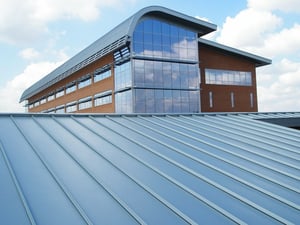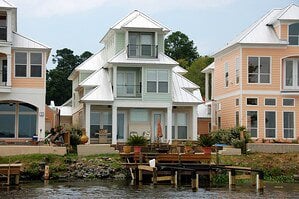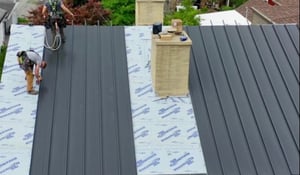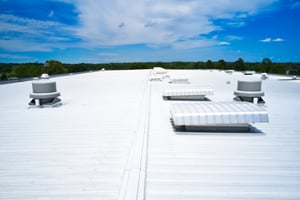Choosing the Best Standing Seam Roofing (SSR) System
Desmond Tutu once said, “there is only one way to eat an elephant: a bite at a time.” And while chances are none of us will ever literally eat an elephant, the words can offer great advice when a task seems too big or overwhelming to tackle.
 Admittedly, trying to choose the best standing seam roofing system can feel like one of those tasks. But if you take Desmond’s advice and take things one step (and decision) at a time, it’s quite manageable.
Admittedly, trying to choose the best standing seam roofing system can feel like one of those tasks. But if you take Desmond’s advice and take things one step (and decision) at a time, it’s quite manageable.
Roof slope
One of the first criteria when selecting which standing seam metal roofing (SSR) system to use should always be the roof’s slope. Some systems are designed to work at pitches as low as ¼:12 while others require minimum slopes of 3:12. A host of factors affect the recommended minimum slope. As you might expect, the height of the panel leg is a consideration. But more importantly, is the panel engagement method. As a good rule of thumb, mechanically seamed systems perform better in lower slope situations like ½:12, where snap-together type systems perform best at slopes 3:12 and above.
It’s important to note that you can always install a system on a greater slope. But systems shouldn’t be installed on a lower slope than recommended by the manufacturer without manufacturer project review and approval. Exceptions are made given criteria like geographic location and building geometry, but they are rare.
Bottom line: when faced with a roof slope below 3:12, you can automatically remove all rated systems for 3:12 and above from consideration, effectively narrowing the field and making the decision easier.
Roof Geometry
 The roof geometry is also an essential factor in panel selection. For example, trapezoidal panels (like our ML90/ML90 FS) can perform well and offer the lowest installed cost on straight gable buildings, yet putting the same panel on a valley condition project would be a poor choice. The difference is due to the panel shape because they have a large open area at the bottom and top of the panel that can make water tightness challenging. The same might apply to buildings with numerous hips and curbs.
The roof geometry is also an essential factor in panel selection. For example, trapezoidal panels (like our ML90/ML90 FS) can perform well and offer the lowest installed cost on straight gable buildings, yet putting the same panel on a valley condition project would be a poor choice. The difference is due to the panel shape because they have a large open area at the bottom and top of the panel that can make water tightness challenging. The same might apply to buildings with numerous hips and curbs.
Bottom line: It’s typically best for buildings with complicated roof plans to use vertical seam style panels since they are much easier to watertight.
Building size also enters into the equation because some systems are designed to allow the panels to be lapped end to end to facilitate longer panel runs, and other panels are not. Vertical leg mechanically seamed systems (like our Maxima) represent an excellent example of a product that can be lapped end to end, where T-style panels (like our 238T) are an example of a system that must be installed in a single piece panel.
However, if you’re leaning towards a T-style panel but face panel lengths longer than what can be factory produced and delivered, don’t despair. Several manufacturers (including McElroy Metal) now can produce “some” of their panel offering on-site with factory quality equipment in lengths up to 250’ long. Hence, it’s always worth a call to check out job site production availability for your desired system before removing a product from consideration.
Bottom line: always consider your approximate panel length and lapability, if necessary, in your system selection.
Substructure
 The structure of the building should also be considered in your system selection. Some SSR systems can span wood or steel purlins, while others require a solid deck. It’s important to note that typically systems with spanning capability can also be installed over a solid deck, but the opposite doesn’t hold. With that said, standing seam roof systems are indeed a “system” and involve numerous parts and pieces, so it’s always best to confirm with the manufacturer before installing a system with spanning capabilities over a solid deck.
The structure of the building should also be considered in your system selection. Some SSR systems can span wood or steel purlins, while others require a solid deck. It’s important to note that typically systems with spanning capability can also be installed over a solid deck, but the opposite doesn’t hold. With that said, standing seam roof systems are indeed a “system” and involve numerous parts and pieces, so it’s always best to confirm with the manufacturer before installing a system with spanning capabilities over a solid deck.
Bottom line: If you’re dealing with a project with purlins instead of a solid deck, you can remove all the systems from consideration that require a solid deck.
Design Criteria
Uplift values can also vary significantly from system to system, so the building’s design criteria should be considered. While the panels that comprise a standing seam metal roof system may look somewhat similar, many different variables affect their performance. Factors like the height of the rib, how they are attached to the deck, clip design and gauge, the width and gauge of the panel, and even if they are mechanically seamed together or snapped all affect how they perform against the wrath of mother nature and ultimately their ability to meet local building codes and other design criteria.
Bottom line: Know your design criteria and consider only systems which meet your criteria. And when unsure, always seek out technical help from an engineer with your preferred manufacturer.
Penetrations
 As mentioned earlier, some system styles can be more forgiving and easier to make watertight than others. Hence, it’s also essential to consider the quantity and type of penetrations on the project. For a straightforward project where penetrations are limited to simple plumbing vent pipes, almost any system will be acceptable.
As mentioned earlier, some system styles can be more forgiving and easier to make watertight than others. Hence, it’s also essential to consider the quantity and type of penetrations on the project. For a straightforward project where penetrations are limited to simple plumbing vent pipes, almost any system will be acceptable.
Yet, for a project with multiple rooftop-mounted curbs, system selection becomes much more critical. While trapezoidal style systems might offer the lowest cost, again, they would be an inferior product selection given the large opening at the panel ends and the challenge to make them watertight. Instead, vertical seam systems, like our Maxima or 238T, would be the preferred type of system.
Bottom line: For roofs with multiple/involved penetrations, vertical seam systems are preferred.
Building Repairs/Modifications
 A properly selected and installed standing seam roof system can easily last 50 years. So while we don’t expect you to spend hours gazing into your crystal ball, thinking about what changes or modifications may be needed over the life of the roof is another fair consideration.
A properly selected and installed standing seam roof system can easily last 50 years. So while we don’t expect you to spend hours gazing into your crystal ball, thinking about what changes or modifications may be needed over the life of the roof is another fair consideration.
Like our 138T/238T, some roofing systems offer single panel replaceability while other vertical leg panels, like our Maxima, do not. The difference is that panels that offer single panel replaceability are butted together, where those that aren’t needed to be hooked and rolled into place during the installation process.
As you can imagine, making a repair, adding a curb, or even adding to a building can be incredibly problematic with interconnected systems.
Bottom line: For buildings where any modifications are anticipated to the roofing system, the best bet is always to consider a system that offers individual panel replaceability. Sure, you will pay a bit more up front but you’ve also effectively removed the risk of tearing off a perfectly good roof to address a problem.
Warranties
The topic of warranties also bears consideration in the selection process. Most commercial standing seam roof systems (SRS) are coated with a PVDF (or Kynar 500® coating) and consequently include robust finish warranties; however, weather tightness warranties are not automatically incorporated and are not available with every system. Since their availability isn’t guaranteed, If a weather tightness warranty is desired, it should be a definite consideration during the panel selection phase.
Most manufacturers, McElroy included, have pre-established guidelines regarding which of their systems they make available with a weather tightness warranty. The roof slope and panel style are two of the significant criteria considered. Another typically involves whether the system is deemed hydrostatic (watertight) or hydrokinetic (water-shedding).
Bottom line: If your project requires a weather tightness warranty, limit your product selection to systems where one is available. To learn more about weather tightness warranties, read our earlier blog, “Are Weather Tightness Warranties Worth the Money?”
Aesthetics
While many people want to start their SSR selection with aesthetics, they should be one of the last considerations. Don’t misunderstand: we agree that a standing seam roof can be a beautiful element to any project! But we’ve also seen many projects doomed from the start due to improper product selection. Consequently, it’s always best to figure out which systems will properly function for the specific project and then dig into the fun topic of aesthetics.
So, what types of things should you consider? Small roof areas tend to benefit from narrower pan widths to help with scale and size, for starters. The various vertical leg options’ height and width can do a great job of minimizing or maximizing shadow lines. Batten style and shape can also play a dominant factor in curb appeal. And the color is, of course, always a fun consideration.
 The pan width and condition can also have a significant impact. Standard standing seam pan widths range from 12”-24” with the 24” width panels most often being used on low slope roofs (½:12 or so) where the panels aren’t visible after installation. While 24” panels can be the least expensive width to purchase and install, they also have the highest likelihood of oil canning. But when the roof isn’t visible, cost often wins over aesthetics.
The pan width and condition can also have a significant impact. Standard standing seam pan widths range from 12”-24” with the 24” width panels most often being used on low slope roofs (½:12 or so) where the panels aren’t visible after installation. While 24” panels can be the least expensive width to purchase and install, they also have the highest likelihood of oil canning. But when the roof isn’t visible, cost often wins over aesthetics.
When roofing surfaces are visible, narrower panels are often selected to help mitigate the concern of oil canning. Additionally, several pan “conditions” or profiles within the panel’s pan should be considered to address oil canning. Striations are a widespread pan condition and ordinarily available for no additional cost. While striated panels can tend to look a little busy while holding a sample in your hands, It’s typically tough to tell the difference between a striated panel and a flat panel after installation. The concern of oil canning is significantly reduced, if not entirely removed.
Bottom line: Consider striations and narrow pan widths to address oil-canning concerns.
Summary
So how do you choose the best standing seam roof system? Just follow Desmond Tutu’s advice and take one bite (or decision!) at a time. And if that doesn’t work, contact us. We’re always here to help!
About McElroy Metal
Since 1963, McElroy Metal has served the construction industry with quality products and excellent customer service. The employee-owned components manufacturer is headquartered in Bossier City, La., and has 14 manufacturing facilities across the United States. Quality, service and performance have been the cornerstone of McElroy Metal’s business philosophy and have contributed to the success of the company through the years. As a preferred service provider, these values will continue to be at the forefront of McElroy Metal’s model along with a strong focus on the customer.





.png?width=767&name=The%205%20Most%20Common%20Metal%20Roofing%20Installation%20Mistakes%20(And%20How%20to%20Avoid%20Them).png)
.png?width=440&height=293&name=How%20to%20Install%20Metal%20Roofing%20Over%20Existing%20Metal%20Roofs%20(1).png)


Comments on this article:
Scroll down to the bottom to submit a comment and join the conversation. Need help or have a question? Please contact us. Looking for a distributor or contractor? Please click here to get started.